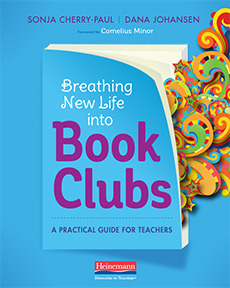Breathing New Life into Classroom Book Clubs
Breathing New Life into Book Clubs: A Practical Guide for Teachers
By Sonja Cherry-Paul and Dana Johansen
(Heinemann, 2019 – Learn more)

Reading Breathing New Life into Book Clubs: A Practical Guide for Teachers this summer made me realize that collaborative reading using book clubs can provide students an engaging and meaningful experience all the while they are applying the logistics.
Throughout the book Sonja Cherry-Paul and Dana Johansen build on their idea for developing life-long readers (in grades 3-8) using an array of examples and research-based evidence. The goal: “to nurture students’ love of reading and their desire to share the experience with others” (3).

At the start of the book the authors explain the what and the why for using book clubs as an approach to foster a love for reading. This information is useful for new and veteran teachers expanding their professional development and wanting to bring a fresh approach to their literacy classroom.
A breakdown for initiating book clubs uses brief summaries to drive the point home that creating a culture of reading is doable if we follow proven procedures for planning, reading, reflection, observations, and assessments.
Students can have meaningful and purposeful conversations
What I love most about this book is that Cherry-Paul and Johansen really mean it when they say it’s a “practical guide.” In addition to the how-to structure, they offer a variety of ideas and examples from various grade levels for each procedure. When I’ve tried book clubs in the past, my students loved reading a common book and meeting together to discuss the story, but I always felt their conversations were not as in-depth as I was hoping they would be.
In chapters four and five, the authors provide what they call “pathway mini lessons” with samples of student work. The lessons offer possible teaching points that can support students’ book club conversations through those moments when the discussion is at risk of faltering. “With some guidance, students are able to engage in rich conversations that are similar to those that occur in adult book clubs” (79).
Ideas worth trying and sharing
By the end of reading Breathing Life into Book Clubs, I found myself developing a book club unit of study that applies the process shared by Cherry-Paul and Johansen. Simply reading the book and jotting down my thoughts was not enough. By actually working on the unit, I was able to anticipate how I can use the book as my toolbox for alternatives when there are rough spots during the implementation process.
Throughout the book, by providing extensive resources Cherry-Paul and Johansen demonstrate their understanding of the challenges teachers could face when integrating or re-integrating book clubs into our classrooms. They write, “We hope our book will inspire you to join us on this journey to breathe new life into book clubs” (13). Yes!
Jacqueline Barreras teaches 5th grade for the School District of Palm Beach County in Florida. She has a Master’s of Science in Elementary Education and has been recognized by the state of Florida as a High Impact Teacher. She loves learning alongside her students in order to help them continue to grow. She also loves camping with her family and reading.

































